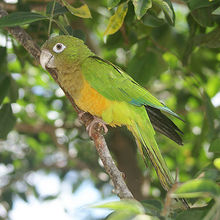| Caatinga parakeet | |
|---|---|

| |
| Conservation status | |
 Least Concern (IUCN 3.1) | |
| CITES Appendix II (CITES) | |
| Scientific classification | |
| Domain: | Eukaryota |
| Kingdom: | Animalia |
| Phylum: | Chordata |
| Class: | Aves |
| Order: | Psittaciformes |
| Family: | Psittacidae |
| Genus: | Eupsittula |
| Species: | E. cactorum |
| Binomial name | |
| Eupsittula cactorum (Kuhl, 1820) | |

| |
The Caatinga parakeet (Eupsittula cactorum), also called the cactus parakeet and in aviculture the cactus conure, is a species of bird in subfamily Arinae of the family Psittacidae, the African and New World parrots. It is endemic to eastern Brazil.
Taxonomy and systematics
The Caatinga parakeet has two subspecies, the nominate E. c. cactorum (Kuhl, 1820) and E. c. caixana (Spix, 1824). The Cattinga parakeet and the brown-throated parakeet (E. pertinax) form a species pair.
Description
The Caatinga parakeet is about 25 cm (9.8 in) long. The sexes are alike. Adults of the nominate subspecies have a pale brown forecrown, cheeks, throat, sides of the neck, and breast. Bare whitish skin surrounds their eye. Their belly and vent area are yellow-orange. Their nape, ear coverts, upperparts, and tail are green. Their wings are mostly green with bluish flight feathers. Immature birds are similar to adults but have a completely green crown and duller underparts. Subspecies E. c. caixana has the same plumage pattern as the nominate but is overall paler.
Distribution and habitat
The Caatinga parakeet subspecies E. c. caixana is the more northerly of the two. It is found in northeastern Brazil from Maranhão east to the Atlantic Ocean and south as far as northwestern Bahia. The nominate subspecies is found in east-central Brazil south of the São Francisco River in Bahia and Minas Gerais. The species inhabits pristine and second-growth caatinga, a dry landscape characterized by thorny vegetation, shrubs, and succulents. It also occurs in cerrado and moister woodlands.
Behavior
Movement
The Caatinga parakeet has no known movement pattern, but it probably makes local movements in response to the availability of food.
Feeding
The Caatinga parakeet's diet has not been fully investigated. It is known to feed on fruits of figs (Ficus), cactus, and several other plants. It has been reported feeding on flower buds. It also feeds on crops like rice, maize and sorghum.
Breeding
The Caatinga parakeet's breeding season is not well defined, but it seems to be within the August to March period. It typically excavates its nest in arboreal termitaria. The clutch's range in the wild is not known for certain but nests with up to six eggs have been found. In captivity the typical clutch size is six, the incubation period is at least 16 days, and fledging occurs about six weeks after hatch.
|
Songs and calls Listen to Caatinga parakeet on xeno-canto |
Vocalization
The Caatinga parakeet's flight calls are "high-pitched screeching 'scraart scraart' cries, as well as a softer, shorter and bisyllabic 'tchit tchit' and loud 'cherr-chee'."
Status
The IUCN has assessed the Caatinga parakeet as being of Least Concern. It has a large range and though its population size is not known it is believed to be stable. No immediate threats have been identified. It is the most common parrot in some parts of its range. "However, caatinga is poorly protected (0.1% of original area inside reserves) and being steadily degraded."
References
- ^ BirdLife International (2016). "Cactus Parakeet Eupsittula cactorum". IUCN Red List of Threatened Species. 2016: e.T22685748A93085356. doi:10.2305/IUCN.UK.2016-3.RLTS.T22685748A93085356.en. Retrieved 15 March 2023.
- "Appendices | CITES". cites.org. Retrieved 4 March 2023.
- ^ Gill, F.; Donsker, D.; Rasmussen, P., eds. (January 2023). "Parrots, cockatoos". IOC World Bird List. v 13.1. Retrieved 18 February 2023.
- ^ Collar, N. and P. F. D. Boesman (2020). Cactus Parakeet (Eupsittula cactorum), version 1.0. In Birds of the World (J. del Hoyo, A. Elliott, J. Sargatal, D. A. Christie, and E. de Juana, Editors). Cornell Lab of Ornithology, Ithaca, NY, USA. https://doi.org/10.2173/bow.cacpar1.01 retrieved March 15, 2023
- ^ van Perlo, Ber (2009). A Field Guide to the Birds of Brazil. New York: Oxford University Press. pp. 124–125. ISBN 978-0-19-530155-7.
Further reading
- Oliveira, Maria Madalena S.; Araújo, Nayone L.L.C.; Raposo, Ana Cláudia S.; Torezani, Josiano C.; Menezes, Íris Daniela S.; Oriá, Arianne P. (27 February 2019). "Reference Values for Selected Ophthalmic Diagnostic Tests in the Caatinga Parakeet (Eupsittula Cactorum) and Yellow-Chevroned Parakeet (Brotogeris Chiriri)". Avian Biology Research. 10 (4): 211–217. doi:10.3184/175815617X14951979279286. S2CID 90782607.
- Martins, Bruno Araujo; Rodrigues, Giovanna Soares Romeiro; de Araújo, Carlos Barros (April 2018). "Vocal dialects and their implications for bird reintroductions". Perspectives in Ecology and Conservation. 16 (2): 83–89. doi:10.1016/j.pecon.2018.03.005.
- de Oliveira, Wallisson Sylas Luna; de Faria Lopes, Sérgio; Alves, Rômulo Romeu Nóbrega (11 June 2018). "Understanding the motivations for keeping wild birds in the semi-arid region of Brazil". Journal of Ethnobiology and Ethnomedicine. 14 (1): 41. doi:10.1186/s13002-018-0243-6. PMC 5996533. PMID 29891010.
External links
- World Parrot Trust Parrot Encyclopedia - Species Profiles
- Cactus parakeet: Photos, sounds from The Birds of the Interior of Ceará, Brazil
| Taxon identifiers | |
|---|---|
| Eupsittula cactorum | |
